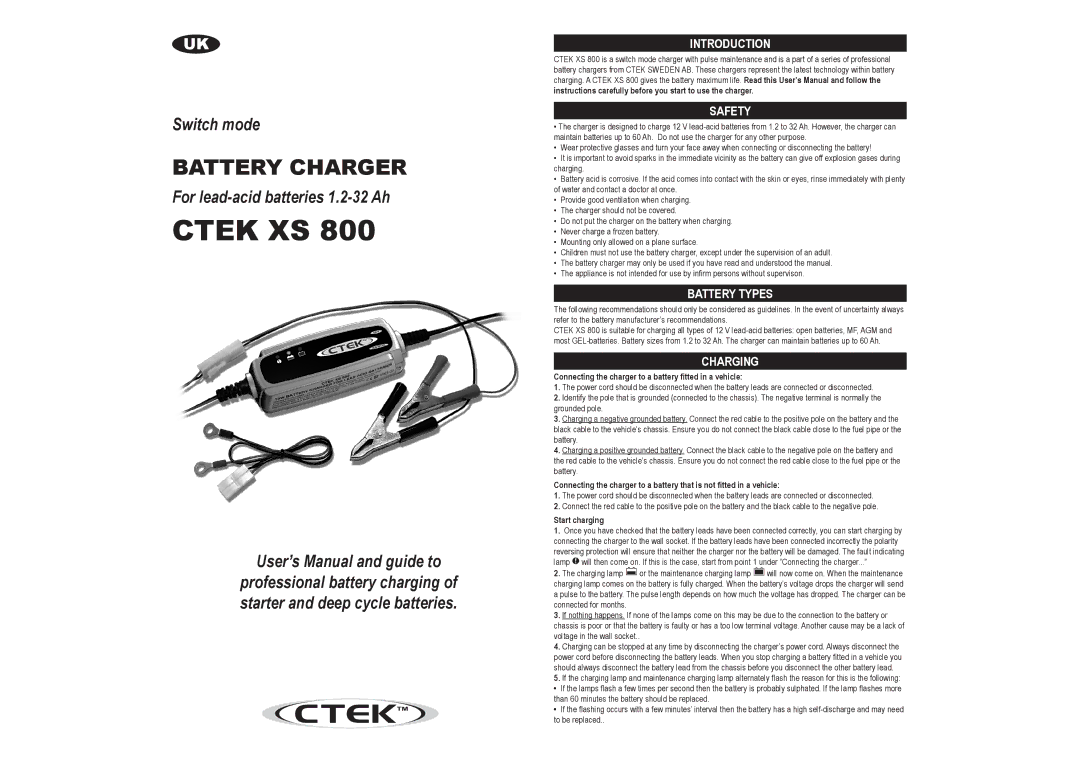
UK
Switch mode
BATTERY CHARGER
For
CTEK XS 800
User’s Manual and guide to
professional battery charging of starter and deep cycle batteries.
INTRODUCTION
CTEK XS 800 is a switch mode charger with pulse maintenance and is a part of a series of professional battery chargers from CTEK SWEDEN AB. These chargers represent the latest technology within battery charging. A CTEK XS 800 gives the battery maximum life. Read this User’s Manual and follow the instructions carefully before you start to use the charger.
SAFETY
•The charger is designed to charge 12 V
•Wear protective glasses and turn your face away when connecting or disconnecting the battery!
•It is important to avoid sparks in the immediate vicinity as the battery can give off explosion gases during charging.
•Battery acid is corrosive. If the acid comes into contact with the skin or eyes, rinse immediately with plenty of water and contact a doctor at once.
•Provide good ventilation when charging.
•The charger should not be covered.
•Do not put the charger on the battery when charging.
•Never charge a frozen battery.
•Mounting only allowed on a plane surface.
•Children must not use the battery charger, except under the supervision of an adult.
•The battery charger may only be used if you have read and understood the manual.
•The appliance is not intended for use by infirm persons without supervison.
BATTERY TYPES
The following recommendations should only be considered as guidelines. In the event of uncertainty always refer to the battery manufacturer’s recommendations.
CTEK XS 800 is suitable for charging all types of 12 V
CHARGING
Connecting the charger to a battery fitted in a vehicle:
1.The power cord should be disconnected when the battery leads are connected or disconnected.
2.Identify the pole that is grounded (connected to the chassis). The negative terminal is normally the grounded pole.
3.Charging a negative grounded battery. Connect the red cable to the positive pole on the battery and the black cable to the vehicle’s chassis. Ensure you do not connect the black cable close to the fuel pipe or the battery.
4.Charging a positive grounded battery. Connect the black cable to the negative pole on the battery and the red cable to the vehicle’s chassis. Ensure you do not connect the red cable close to the fuel pipe or the battery.
Connecting the charger to a battery that is not fitted in a vehicle:
1.The power cord should be disconnected when the battery leads are connected or disconnected.
2.Connect the red cable to the positive pole on the battery and the black cable to the negative pole.
Start charging
1.Once you have checked that the battery leads have been connected correctly, you can start charging by connecting the charger to the wall socket. If the battery leads have been connected incorrectly the polarity reversing protection will ensure that neither the charger nor the battery will be damaged. The fault indicating lamp ![]() will then come on. If this is the case, start from point 1 under ”Connecting the charger...”
will then come on. If this is the case, start from point 1 under ”Connecting the charger...”
2.The charging lamp ![]()
![]()
![]() or the maintenance charging lamp
or the maintenance charging lamp ![]()
![]()
![]()
![]()
![]() will now come on. When the maintenance charging lamp comes on the battery is fully charged. When the battery’s voltage drops the charger will send a pulse to the battery. The pulse length depends on how much the voltage has dropped. The charger can be connected for months.
will now come on. When the maintenance charging lamp comes on the battery is fully charged. When the battery’s voltage drops the charger will send a pulse to the battery. The pulse length depends on how much the voltage has dropped. The charger can be connected for months.
3.If nothing happens. If none of the lamps come on this may be due to the connection to the battery or chassis is poor or that the battery is faulty or has a too low terminal voltage. Another cause may be a lack of voltage in the wall socket..
4.Charging can be stopped at any time by disconnecting the charger’s power cord. Always disconnect the power cord before disconnecting the battery leads. When you stop charging a battery fitted in a vehicle you should always disconnect the battery lead from the chassis before you disconnect the other battery lead.
5.If the charging lamp and maintenance charging lamp alternately flash the reason for this is the following:
• If the lamps flash a few times per second then the battery is probably sulphated. If the lamp flashes more than 60 minutes the battery should be replaced.
• If the flashing occurs with a few minutes’ interval then the battery has a high
